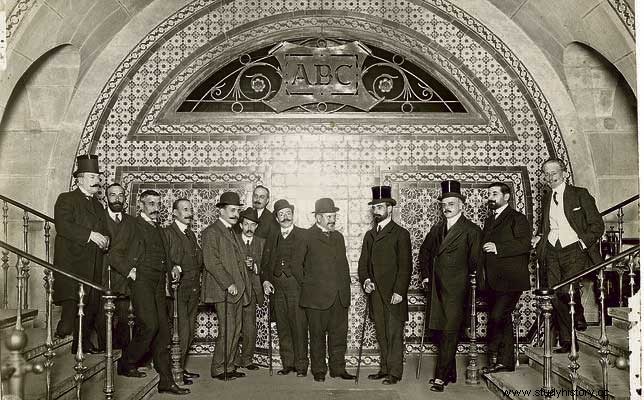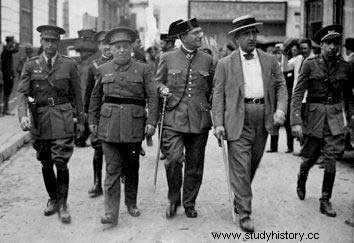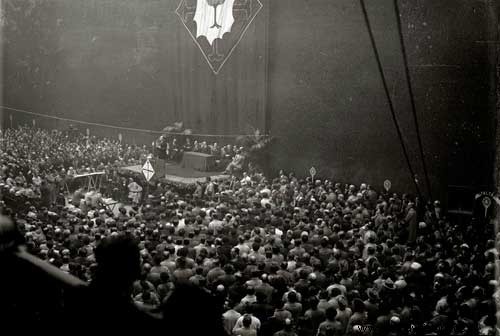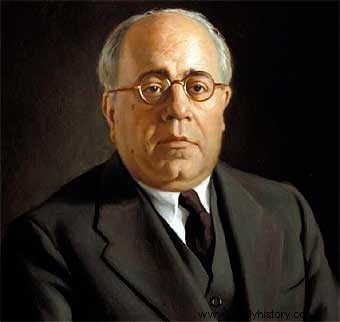The reformist biennium It was a stage which began from the proclamation of the 14th of 1931 until the elections in November 1933 in which multiple changes and reforms took place in the state.
The democratic path undertaken is evident both in the open holding of elections and in the process of drafting the new Constitution. More problems have the attempt, in a short space of time, to generalize secularism or modernize the agrarian structures of the country.
From the outset, shortly after being appointed Minister of War in the Provisional Government, Azaña has carried out an impeccable reform from a technical point of view which, however, is neither agreed upon by those affected nor accompanied by a modernization of the own army, raising, again, opposition and hostility. In this way, the Republic wins in its first two years of existence the rejection, which will end up costing it so dearly, from the Church, the landowners and part of the army.
Social Reforms
In its eagerness to make up for lost time, the Republic launched an ambitious educational plan:between 1931 and 1933 more than 7,000 teachers were qualified and more than 10,000 new schools were created. The Church, which up to that moment has dealt practically without competence with education in Spain, is severely affected. Following the constitutional precept, teaching by religious orders is prohibited and the Society of Jesus is dissolved. Other decisions aimed at restricting the presence of religion in the public sphere, the approval of divorce, the law on civil cemeteries or conflicts with the ecclesiastical hierarchy end up mobilizing Catholics, if they were not already enough, against the new regimen.
Agrarian Reform
The agrarian reform, approved in September 1932, attempts to redistribute land ownership, mostly in the hands of the landed nobility. For this, it relies on the expropriation of large estates and the settlement of peasants on the expropriated lands. The rejection of those affected and the slowness of the bureaucratic procedures prevent sufficient progress, although they manage, once again, to confront the Republic with powerful social sectors. In addition, attempts are being made to reform the army, which suffers from an excess of officers and is too involved in political affairs.
Territorial Problem in the Reform Biennium
Together with these reforms, the territorial question, especially the Catalan one, is another of the axes of discussion around which Republican politics revolves. Since the last quarter of the 19th century and mainly since the «disaster» of 1898, certain Catalan social sectors and, to a lesser extent, Basques and Galicians, will promote the knowledge and recognition of their cultural differences, which, little by little, manage to articulate themselves politically.
Regionalist League
During the reign of Alfonso XIII, the Catalan political class was grouped around the Lliga Regionalista, a conservative party of the bourgeoisie that would form an active part of Spanish politics at the time and was led by Prat de la Riba (founder of the Institut d' Estudis Catalans), until his death in 1917, and Francesc Cambó, later. The link between the Lliga and the monarchy encourages other leftist Catalan groups to lead the transition to the new republican regime.

Proclamation of the Catalan State
Politicians such as Carrasco Formiguera, for Acció Catalana, Matías Malliol, for Acció Republicana de Catalunya, and Jaume Aiguader, for Estat Catalá, will form part of the San Sebastián pact. Together with them, the Galician Santiago Casares Quiroga, for the ORGA, completes the representation of regionalisms; the Basque Nationalist Party, anchored in its particular traditionalism, did not sign the Pact. With the advent of the Republic, on April 14, Colonel Maciá, co-founder with Lluís Companys of Esquerra Republicana de Catalunya, proclaimed, as has already been pointed out, the Catalan State, inviting other regions to join in an Iberian federation. Frightened by Maciá's unexpected action, the Provisional Government sends two of its Catalan ministers, Marcelino Domingo and Nicolau d'Olwer, to Barcelona, together with a socialist Fernando de los Ríos, to try to stop an operation that could have fatal consequences for the new system.
Approval of the Catalan Statute

The ministers Marcelino Domingo, Nicolau d'Olwer and the socialist Fernando de los Ríos manage to convince the old Catalan leader to wait for the elaboration of a republican Constitution that, as agreed in San Sebastián, will include autonomy for Catalonia, and the approval of its Statute by the Cortes. In exchange, Maciá will preside over the Generalitat, which in the months that pass until the constitutional text is approved, acts as a pre-autonomous regime, while Companys is appointed civil governor of Barcelona, at first, and minister of the Navy, after the formation of the Government of Azaña. Between the months of May and September 1932, the Catalan Statute project was discussed in Parliament, giving rise to quite a few confrontations. It was finally approved on September 15, 1932. After the revolution of October 1934 - which we will address later - the Generalitat will be dissolved; His restitution will come hand in hand with the victory of the Popular Front in the elections of February 1936.
Basque Statute
In the case of the Basque Statute, it has more problems due to Navarre's resignation to join it and the lack of enthusiasm it arouses in Alava (where 50% of the votes were not reached in the November 1933 referendum), so which will not be approved until October 1936, once the war has begun. The Galician Statute of autonomy is endorsed in June 1936, without having time to discuss it in the Cortes.
August 1932 Coup Attempt
In the months that have elapsed since the proclamation of the Republic, and especially since the approval of the Constitution and the arrival of Azaña as President of the Government, the young political system has gained powerful enemies with each decision made. Barely sixteen months after the exciting April 14, in August 1932, General Sanjurjo executed a coup. Encouraged by the sectors affected by the reforms, motivated by the political situation and offended by his departure from the Civil Guard, from whose command he had favored the arrival of the new regime, Sanjurjo spoke in Seville, waiting to be followed by the rest of the army. The poorly planned operation is a resounding failure.

Creation of new parties
The Catholic right, given the situation generated, chooses to organize itself politically. At the end of 1932 the Spanish Confederation of Autonomous Rights (CEDA) was founded, led by Gil Robles, who intended to reverse the reforms initiated by the Republic , especially those that affect the religious question, and whose diffuse goal is a system far from pluralism, closer to those that have been configured in Mussolini's Italy or Salazar's Portugal. On a social base of peasants and urban middle classes and under a program of defense of religion (as opposed to the republicans) and property (as opposed to the socialists), the CEDA puts all its efforts into putting an end to the government and amend the Constitution.
Self-styled fascist groups make their appearance also at this time in Spain, late if compared to what happened in other surrounding countries.
In 1931, Ramiro Ledesma and Onesimo Redondo created the Juntas de Offensiva Nacional Sindicalista (JONS), an organization that defined itself as National Socialist, to which the Spanish Falange, led by José Antonio Primo de Rivera, joined in 1933 . Both organizations came together a year later, in 1934, giving rise to the Falange Española de las JONS. Since their creation, these groups have aimed to generate a destabilizing climate that allows them to impose, through violence, their ideology, impossible to achieve in any other way. Although his presence is great, due to his constant participation in riots and assassinations, his acceptance is scarce, obtaining two deputies in the 1933 elections and none (with less than 0.5% of the votes) in those of 1936.
For its part, the confrontational policy of the National Confederation of Workers (CNT), the anarchist union , which provokes the violent reaction of the forces of public order (as in Casas Viejas, where fourteen peasants die), and the constant labor unrest (an entire rosary of strikes and confrontations), complete a panorama of constant harassment of a political system as in need of support. Another small party, the communist, won a deputy in the 1933 elections . His Bolshevik program and his revolutionary politics caused quite a few clashes with fascist groups, both groups transferring their discussion to the street.

Crisis of the Government of Azaña
The economic crisis, a consequence of the crash of 1929, which considerably raised unemployment levels; the political mobilization of the Church to reverse the path traveled; the wearing down of Azaña as a result of the campaign unleashed after the events in Casas Viejas (in which both the left and the socialists harass the government); and the pressure to which the President of the Republic is subjected, motivate the withdrawal, by him, of confidence in the Chief of the Cabinet. The departure of Azaña from the Government and the inability of Lerroux to constitute a new one motivated the dissolution of the Cortes, the appointment of Martínez Barrio, on October 8, 1933, as head of the Government and the early call for an electoral process. 
